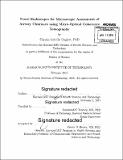| dc.contributor.advisor | Guillermo J. Tearney. | en_US |
| dc.contributor.author | Unglert, Carolin Isabella | en_US |
| dc.contributor.other | Harvard--MIT Program in Health Sciences and Technology. | en_US |
| dc.date.accessioned | 2015-07-17T19:51:03Z | |
| dc.date.available | 2015-07-17T19:51:03Z | |
| dc.date.copyright | 2015 | en_US |
| dc.date.issued | 2015 | en_US |
| dc.identifier.uri | http://hdl.handle.net/1721.1/97830 | |
| dc.description | Thesis: S.M., Harvard-MIT Program in Health Sciences and Technology, 2015. | en_US |
| dc.description | Cataloged from PDF version of thesis. | en_US |
| dc.description | Includes bibliographical references (pages 73-77). | en_US |
| dc.description.abstract | The health of the human respiratory system depends critically on airway clearance via motile hair-like structures (cilia), which transport and eliminate unwanted particles trapped within mucus. Impairment of mucociliary clearance (MCC) can lead to life-threatening airway narrowing and lung infections, and is a major cause of morbidity and mortality in patients with cystic fibrosis, primary ciliary dyskinesia and chronic obstructive lung disease. However, no tool for microscopic in-vivo visualization of ciliary function is currently available, limiting studies of disease pathogenesis, refined diagnosis and phenotyping, and the development of novel therapeutics. In this thesis, a novel, 1-pm resolution, optical interferometric imaging technique termed Micro-OCT was incorporated into miniaturized common-path endoscopes and mucociliary transport was visualized in vivo for the first time. The first-generation Micro-OCT probe had a rigid design with outer diameter of 4 mm and a two-prism configuration providing beam splitting and sample beam shaping into an annular profile. Image quality of the probe allowed visualization of the periodic pattern of ciliary beating, measurement of airway surface liquid depth (ASL) and visualization of mucociliary transport. Unaltered ciliary function was demonstrated in a living, spontaneously breathing swine model. Newer generation common-path endoscope designs were demonstrated that improve, among other limitations, the stability of the reference reflector position and provide greater potential for miniaturization. The presented work opens unprecedented avenues for studying MCC and the effect of novel therapeutics within the complexity of a living organism. Further, it lays the groundwork for the development of a human probe with the potential to revolutionize diagnosis, phenotyping, and therapy management for all patients with respiratory disease involving the mucociliary escalator. | en_US |
| dc.description.statementofresponsibility | by Carolin Isabella Unglert. | en_US |
| dc.format.extent | 77 pages | en_US |
| dc.language.iso | eng | en_US |
| dc.publisher | Massachusetts Institute of Technology | en_US |
| dc.rights | M.I.T. theses are protected by copyright. They may be viewed from this source for any purpose, but reproduction or distribution in any format is prohibited without written permission. See provided URL for inquiries about permission. | en_US |
| dc.rights.uri | http://dspace.mit.edu/handle/1721.1/7582 | en_US |
| dc.subject | Harvard--MIT Program in Health Sciences and Technology. | en_US |
| dc.title | Novel endoscopes for microscopic assessment of airway clearance using micro-optical coherence tomography | en_US |
| dc.type | Thesis | en_US |
| dc.description.degree | S.M. | en_US |
| dc.contributor.department | Harvard University--MIT Division of Health Sciences and Technology | |
| dc.identifier.oclc | 913232611 | en_US |
